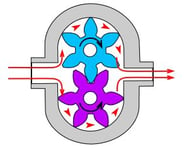Home » Blog » Sliding Vane vs Rotary Gear Pump Pros and Cons
Sliding Vane vs Rotary Gear Pump Pros and Cons

With so many choices available for industrial pumps, the selection process often comes down to carefully evaluating the needs of the industry and choosing a pump that will be efficient and reliable in a specific application.
The case is no different when selecting sliding vane and rotary gear pumps. While both are types of positive displacement pumps, there are nuances that make one or the other better suited for a particular application.
What is a Gear pump and How Does It Work?
 Gear pumps are positive displacement pumps that pump liquid by locking them between intermeshing gears. The rotation of the gears transports the fluid from the inlet to the outlet. There are two types of gear pumps – internal and external. Gears pumps provide constant fluid flow under different pressure conditions.
Gear pumps are positive displacement pumps that pump liquid by locking them between intermeshing gears. The rotation of the gears transports the fluid from the inlet to the outlet. There are two types of gear pumps – internal and external. Gears pumps provide constant fluid flow under different pressure conditions.
What is a Sliding Vane Pump and How Does It Work?
A sliding vane pump uses a rotor with sliding vanes that creates suction between the vanes when the rotor rotates, thereby drawing the fluid behind each vane. The rotation carries the fluid between the inlet and the outlet. This type of construction allows sliding pumps to deliver constant flow under different pressure conditions.
Sliding Vane Pump vs. Rotary Gear Pump
While both sliding and rotary gear pumps are considered positive displacement pumps, the differences in their construction give them unique characteristics. Let us explore some of them in detail.
Handling Viscous Fluids
Sliding vane pumps have average performance in pumping viscous fluids. This is mainly because viscous fluids cannot easily enter the cavities formed within the pump. For pumping high viscous fluids, the speed of the sliding vane pumps must be lowered significantly.
Gear pumps, especially internal gear pumps, are great at handling viscous fluids. Their ability to work at slow speeds with minimal inlet pressure makes them ideal for viscous fluids.
Rotary Gear Pumps are best for handling viscous fluids
Handling Thin Fluids
Sliding vane pumps excel in pumping thin fluids. Their design makes it easier for the low viscosity fluids to enter the cavities. Therefore, the pump exhibits good suction capability.
Gear pumps are good at handling low viscosity fluids. However, they don’t compare to the performance of sliding vane pumps.
Sliding vane pumps are best for handling thin fluids
Handling Solids
Both gear and sliding vane pumps create pumping action with tight clearances. Pumping solids can significantly affect these clearances in a negative way, and the pumps can even lose their efficiency drastically.
Neither gear nor sliding vane pumps are recommended for pumping solids.
Ability to handle wear
Sliding vane pumps are better at handling wear. Since the vanes can be easily adjusted, these pumps are often referred to as wear adjusting pumps, where the pump automatically adjusts for the wear to maintain efficiency throughout its lifetime. If the wear becomes excessive to the degree that the pump cannot self-compensate, you can easily swap out the vanes.
Gear pumps wear at the meshing surface. A high degree of wear can introduce play between the meshing surfaces of the gears, causing the pump to lose its efficiency.
Sliding vane pumps are best at handling wear
Need Assistance in Selecting the Right Pump?
While both sliding vane pumps and rotary gear pumps have pros and cons, choosing between them depends largely on your specific fluid transport application. With over 40 application specialists on staff, Hayes Pump can help you find the right pumps for your requirements and have the setup running in no time.




